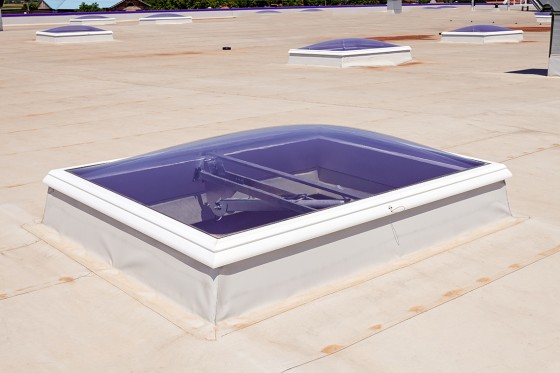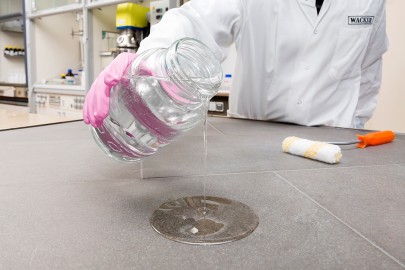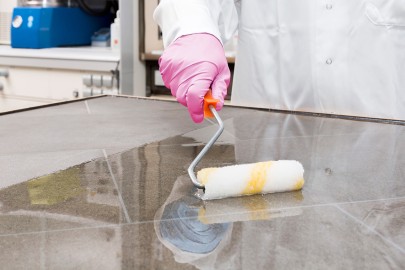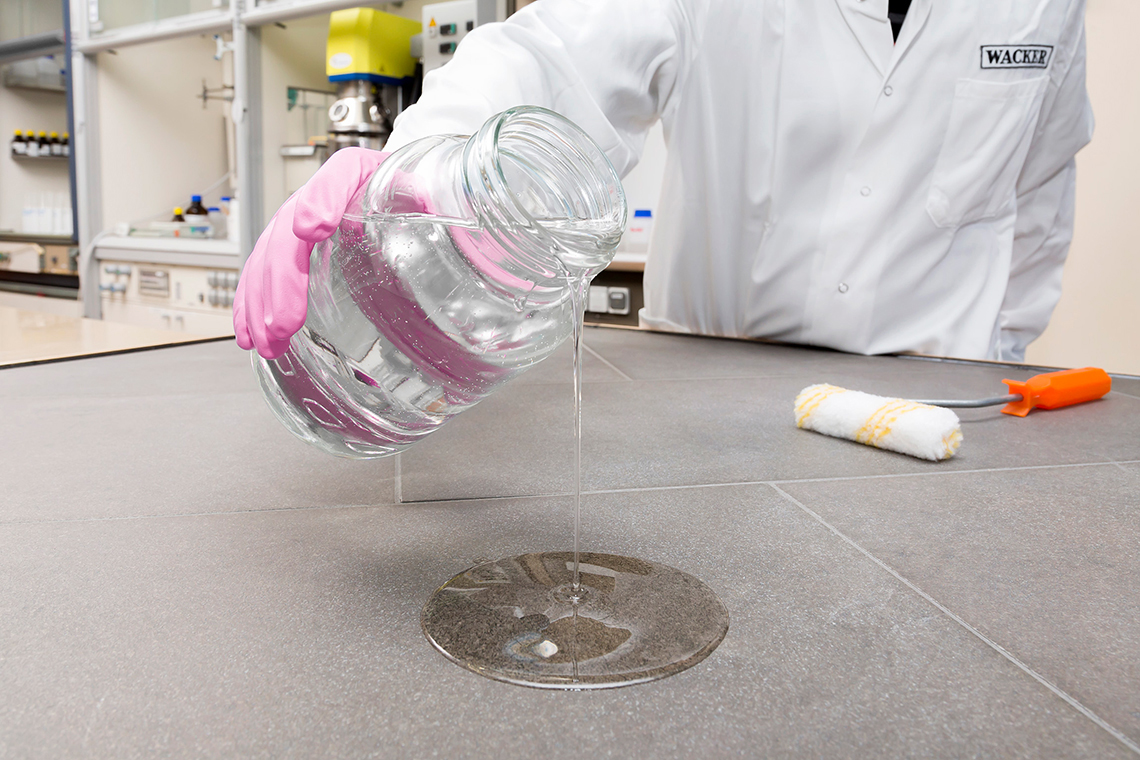Letting Bonds Flex Their Muscles
The materials used for bonded joints and waterproofing membranes that come under high dynamic stress need to be elastic and tear resistant. Novel silane-terminated polymers from the GENIOSIL® XT series open up the benefits of silane-crosslinking to such applications as well.

When General Motors first bonded windshields into the body of test vehicles in 1963, the car company heralded the demise of prefabricated rubber gaskets. Adhesive joints became standard in the US car industry in 1978, and worldwide soon after – not only because they proved more cost effective, but also because they enhanced safety, making the glass less likely to shatter in the event of an accident. Elastic adhesive joints became a key technology in other sectors as well – particularly in cases where the bond is affected by forces that constantly vary over time.
Elastic bonding is widely used in road and rail vehicles to connect components to the load-bearing structure, such as the body or frame. The building sector, on the other hand, uses elastic waterproofing membranes to compensate for thermally induced stresses in the substrate while reliably bridging cracks.
The extent to which elastic adhesives and waterproofing membranes meet these requirements depends on the binders employed and the compounder’s knowledge. GENIOSIL® XT, a new product series from WACKER, yields, for the first time, silane-terminated polymers which can be formulated to shear-resistant materials of high tensile strength that are at once highly elastic and extremely tear resistant.

View over the roofs of a Spanish city: since the 1950s, flat roofs have become a well-established feature of commercial and multi-floor residential buildings.
Dynamic loads cause adherends to move. They can only resist these loads if the adhesive layer is both strong enough and permanently capable of moving with the adherends, i.e. it must be capable of stretching elastically.
Shock and vibration are not the sole causes of dynamic loads. Fluctuating temperatures exert stress on bonds, too. Such stress arises when two adherends expand or contract to different degrees under the influence of heat or cold.
A waterproofing membrane is a prime example of this. It is applied in liquid form to the surface to be sealed, such as a balcony or terrace, where it cures to produce a seamless waterproof membrane. Because the substrate constantly moves as the temperature fluctuates, the seal experiences substantial dynamic stress. It has to accommodate the movement of crack edges and continue to bridge them under continual expansion and contraction.
Aside from elasticity, an adhesive must possess tensile strength in everyday applications. The adhesive layer may become damaged in service due to local overloading, whether because of the conditions under which it is used or because a jagged object acts on it from the outside. If the adhesive has inadequate tear resistance, the small damaged area may rip open during the next loading cycle. A liquid waterproofing system based on GENIOSIL
A liquid waterproofing system based on GENIOSIL® XT 50, as being tested here at a WACKER lab in Burghausen, can be used to protect outdoor tiles against moisture and frost.
No matter how they arise, dynamic loads continually generate fluctuating mechanical stresses in the adhesive layer. An elastic adhesive layer moves with the adherends. It spreads the stress across the bonded area, dissipating local stress peaks.
Polyurethane-based adhesives have traditionally been the materials of choice for bonds exposed to highly dynamic stresses; for waterproofing membranes, formulations made with polymethyl methacrylate have also commonly been used. That could now change. “Our silane-modified polymers in the new GENIOSIL® XT product series can be formulated so that the mechanical properties of the cured end products match those of standard adhesives and sealants,” explains Lidia Miszke, Business Development Manager at WACKER SILICONES.
"Products formulated with GENIOSIL® XT have a broader adhesion spectrum than polyurethane-based systems."
Lidia Miszke, Marketing Manager, Construction Sealants & AdhesivesFirm, Extensible and Tear-Resistant
This new product series is based on silane-terminated polyethers. Like typical silanes, the products crosslink and cure upon contact with atmospheric moisture. “The new polymers have been optimized so as to have a low viscosity on the one hand and a high number of silyl groups per unit volume on the other,” explains Dr. Lars Zander, in charge of developing GENIOSIL® XT in WACKER’s Application Technology department in Burghausen. “Consequently, the new polymers build up a solid, yet elastic network as they cure.” He added that the corollary was that adhesive layers and waterproofing membranes based on the new polymers possessed a high internal strength, yet were highly extensible and tear resistant.
Versatile Range of Formulations
The new polymers are extremely versatile when it comes to formulation options. This versatility stems not only from their low viscosity, but also from their compatibility with all other GENIOSIL® silane-modified polymers, with which they can be blended in any proportion to adjust the properties of the binder system to the application.
Easy to Process

GENIOSIL® XT can be used to formulate adhesives that are exempt from labeling requirements, for example for sealing flat roofs.
Thanks to their low viscosity, the new silane-modified GENIOSIL® XT 50 and GENIOSIL® XT 55 polymers can be processed easily and without the need for solvents. This gives them an advantage over many conventional binders. What is more, compounders can formulate the polymers with or without plasticizers and with or without fillers. Again, this adds considerable scope for tailoring the end product to the application, and offers a way to produce highly filled and hence cost-effective end products. Finally, adhesives and sealants formulated with the new polymers can be pigmented in any color, opening up new possibilities for designers.
“Products formulated with GENIOSIL® XT have a broader adhesion spectrum than polyurethane-based systems,” emphasizes WACKER manager Lidia Miszke. “The formulation will determine how they adhere to many common materials without the need for priming.” She went on to say that they were also less moisture-sensitive than polyurethanes, adding that GENIOSIL® XT products did not contain any free isocyanates and so could be formulated to adhesives and sealants that were not subject to labeling requirements.
No Tin Catalyst Needed
An alpha-silane-terminated polymer, GENIOSIL® XT 50 does not require an organo-tin catalyst for rapid curing. It is therefore suitable for producing tin-free industrial adhesives and crack-bridging waterproofing membranes. With GENIOSIL® XT 50, tensile strengths of up to about 9 N/mm² and tear strengths of up to about 50 N/mm (measured as per ASTM D 624 B-91) are feasible. The cured end product has such good mechanical properties that the nonwoven reinforcement traditionally required to seal flat roofs with liquid waterproofing systems can be dispensed with. Moreover, by eliminating fillers, compounders can produce highly transparent adhesives and seals.

GENIOSIL® XT 55 is a gamma-silane-terminated polyether for formulating strong structural industrial adhesives. Such adhesives need to be both highly elastic and extremely tear resistant. Laboratory tests performed with GENIOSIL® XT 55 yielded shear strengths of around 5 N/mm², combined with an elongation at break of around 700 percent and tear strengths of up to 16 N/mm (measured as per DIN ISO 34-1). These values are typical of window adhesives employed in the automotive industry.
“Our new silane-terminated polymers in the GENIOSIL® XT series are suitable for applications involving high dynamic loads,” says Jürgen Herein, head of the Construction Sealants & Adhesives business team at WACKER SILICONES. “They constitute a technically equivalent – in some respects even superior – alternative to established binder systems.”








